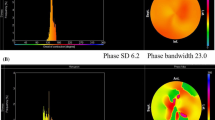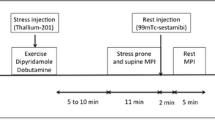Abstract.
It is known that contractile reserve may be blunted if perfusion and coronary flow reserve are reduced. Thus, it is conceivable that the predictive accuracy of dobutamine echocardiography may differ according to perfusion tracer uptake. The aim of this study was therefore to assess the relationship between the level of thallium-201 uptake and the accuracy of dobutamine echocardiography in identifying reversible dysfunction. Sixty-nine patients (age 59±8 years, ejection fraction 40%±11%) with chronic coronary artery disease scheduled for coronary revascularisation were studied. All patients underwent rest 201Tl single-photon emission tomography and two-dimensional echocardiography at rest and during low-dose dobutamine infusion on the same day before revascularisation and repeated echocardiography at least 30 days thereafter. At follow-up, recovery of function was observed in 49% of 339 dysfunctional segments. The percentage of segments with post-revascularisation recovery of function and the percentage with contractile reserve increased in parallel with 201Tl uptake both in the total group of segments (χ2=35.5, P<0.0001 and χ2=35.9, P<0.0001, respectively) and among the 183 akinetic segments (χ2=44.4, P<0.0001 and χ2=14.6, P<0.05, respectively). The dysfunctional segments were divided into three groups according to 201Tl uptake: (a) uptake <65%, (b) uptake between 65% and 79%, (c) uptake >80%. The positive predictive value increased significantly with the level of 201Tl uptake, and was suboptimal (46%) in akinetic segments with severely reduced 201Tl uptake. The negative predictive value decreased significantly with 201Tl uptake, and it was less than suboptimal (29%) in akinetic segments with normal tracer uptake. Sensitivity was lower in the subset of akinetic segments (42%–63%) than in all dyssynergic segments (63%–76%), whereas specificity was very high in akinetic segments (80%–84%). It is concluded that the accuracy of low-dose dobutamine echocardiography in predicting reversibility of regional dysfunction varies considerably according to 201Tl uptake at rest and to the severity of regional dysfunction.
Similar content being viewed by others
Author information
Authors and Affiliations
Additional information
Received 1 March and in revised form 20 June 2001
Electronic Publication
Rights and permissions
About this article
Cite this article
Pace, L., Filardi, P., Cuocolo, A. et al. Diagnostic accuracy of low-dose dobutamine echocardiography in predicting post-revascularisation recovery of function in patients with chronic coronary artery disease: relationship to thallium-201 uptake. Eur J Nucl Med 28, 1616–1623 (2001). https://doi.org/10.1007/s002590100608
Published:
Issue Date:
DOI: https://doi.org/10.1007/s002590100608




